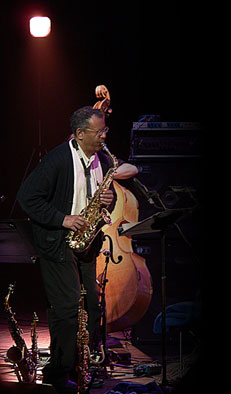
Anthony Braxton
15 November 2004, Royal Festival Hall, London Jazz Festival
A
bespectacled, cardiganed Anthony Braxton takes the stage in front of a packed
auditorium, purposeful gait revealed in his brief stride to the microphone
stand. Accompanying him are four remarkably youthful musicians, who look
as though they’ve yet to reach their mid-twenties. They take positions
around Satoshi Takeishi who sits crosslegged on a low platform, surrounded
by percussion that bears only a distant relationship to a traditional jazz
drumkit. Close to the lip of the stage stand the two wind players, Braxton
and trumpeter Taylor Ho Bynum. Behind them stand Chris Dahlgren on bass
and Mary Halvorson on semi-acoustic guitar.
With nothing by way of introduction the group begin playing methodical, seemingly breathless unison lines, their parallel trajectories cleaved to with an avidity borne of discipline and singular intent. The quintet’s unusual instrumentation offers up a sound that is at once fleet-footed and intense, fierce but airily cushioned. They continue to pursue these intricate lines for perhaps ten minutes, eventually prompting the thought that they might be trying to hothouse a new form of intellectual armour plating. The music certainly resists easy assimilation, interpretations ricocheting harmlessly off into the darkness that surrounds the group. Braxton is silent for much of the time, sometimes frowning but always listening and directing, his numeric cues counted out emphatically on raised fingers.
Although the quintet’s performance is apparently antithetical to the emotive sublimation proffered by most live music, sudden shafts of light illuminate the music: whether it’s an unexpected solo from Braxton that falls over itself in rigorous intensity or brief, melodically rich passages from Ho Bynum that are haunted by the ghost of the blues. Rather than condensing form into ever smaller spaces, Braxton’s music appears attenuated, penumbral even: despite the presence of Chris Dahlgren’s double bass it appears to hover above the stage, unfettered by gravity. This music appears to be composed out of space, air, light: perhaps its very buoyancy is what makes it difficult to define. For such reportedly intellectual music there’s a gentle tactility, as though each player is proceeding by feel rather than the notation they refer to so frequently. This isn’t music that punches in the gut, instead it dazzles the eye and flutters around the ears until something akin to dizziness ensues. For their only encore the group play music that might pass for arthouse ambient made from a conch solo that floats over water-like percussion, fuzzed guitar and double bass. The result is a charming and surprisingly distinct from the set that preceded it.
With nothing by way of introduction the group begin playing methodical, seemingly breathless unison lines, their parallel trajectories cleaved to with an avidity borne of discipline and singular intent. The quintet’s unusual instrumentation offers up a sound that is at once fleet-footed and intense, fierce but airily cushioned. They continue to pursue these intricate lines for perhaps ten minutes, eventually prompting the thought that they might be trying to hothouse a new form of intellectual armour plating. The music certainly resists easy assimilation, interpretations ricocheting harmlessly off into the darkness that surrounds the group. Braxton is silent for much of the time, sometimes frowning but always listening and directing, his numeric cues counted out emphatically on raised fingers.
Although the quintet’s performance is apparently antithetical to the emotive sublimation proffered by most live music, sudden shafts of light illuminate the music: whether it’s an unexpected solo from Braxton that falls over itself in rigorous intensity or brief, melodically rich passages from Ho Bynum that are haunted by the ghost of the blues. Rather than condensing form into ever smaller spaces, Braxton’s music appears attenuated, penumbral even: despite the presence of Chris Dahlgren’s double bass it appears to hover above the stage, unfettered by gravity. This music appears to be composed out of space, air, light: perhaps its very buoyancy is what makes it difficult to define. For such reportedly intellectual music there’s a gentle tactility, as though each player is proceeding by feel rather than the notation they refer to so frequently. This isn’t music that punches in the gut, instead it dazzles the eye and flutters around the ears until something akin to dizziness ensues. For their only encore the group play music that might pass for arthouse ambient made from a conch solo that floats over water-like percussion, fuzzed guitar and double bass. The result is a charming and surprisingly distinct from the set that preceded it.
Colin Buttimer
Published by Me
